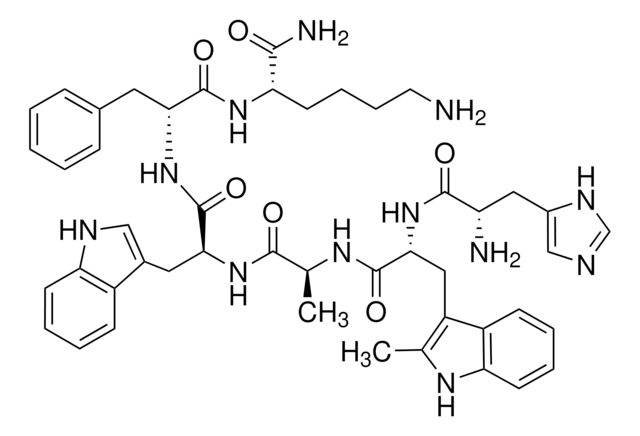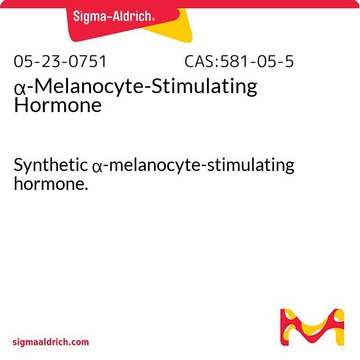Kluczowe dokumenty
M2910
[D-Trp7, Ala8, D-Phe10]-α-Melanocyte Stimulating Hormone Amide Fragment 6-11
≥97% (HPLC)
Synonim(y):
GHRP-6
About This Item
Polecane produkty
Próba
≥97% (HPLC)
temp. przechowywania
−20°C
ciąg SMILES
C[C@H](NC(=O)[C@@H](Cc1c[nH]c2ccccc12)NC(=O)[C@@H](N)Cc3cnc[nH]3)C(=O)N[C@@H](Cc4c[nH]c5ccccc45)C(=O)N[C@H](Cc6ccccc6)C(=O)N[C@@H](CCCCN)C(N)=O
InChI
1S/C46H56N12O6/c1-27(54-44(62)39(20-29-23-51-35-15-7-5-13-32(29)35)57-43(61)34(48)22-31-25-50-26-53-31)42(60)56-40(21-30-24-52-36-16-8-6-14-33(30)36)46(64)58-38(19-28-11-3-2-4-12-28)45(63)55-37(41(49)59)17-9-10-18-47/h2-8,11-16,23-27,34,37-40,51-52H,9-10,17-22,47-48H2,1H3,(H2,49,59)(H,50,53)(H,54,62)(H,55,63)(H,56,60)(H,57,61)(H,58,64)/t27-,34-,37-,38+,39+,40-/m0/s1
Klucz InChI
WZHKXNSOCOQYQX-FUAFALNISA-N
informacje o genach
human ... POMC(5443)
rat ... Ghsr(84022)
Szukasz podobnych produktów? Odwiedź Przewodnik dotyczący porównywania produktów
Amino Acid Sequence
Działania biochem./fizjol.
Opakowanie
Kod klasy składowania
11 - Combustible Solids
Klasa zagrożenia wodnego (WGK)
WGK 3
Temperatura zapłonu (°F)
Not applicable
Temperatura zapłonu (°C)
Not applicable
Środki ochrony indywidualnej
Eyeshields, Gloves, type N95 (US)
Wybierz jedną z najnowszych wersji:
Masz już ten produkt?
Dokumenty związane z niedawno zakupionymi produktami zostały zamieszczone w Bibliotece dokumentów.
Nasz zespół naukowców ma doświadczenie we wszystkich obszarach badań, w tym w naukach przyrodniczych, materiałoznawstwie, syntezie chemicznej, chromatografii, analityce i wielu innych dziedzinach.
Skontaktuj się z zespołem ds. pomocy technicznej







![[Nle4, D-Phe7]-α-Melanocyte Stimulating Hormone trifluoroacetate salt ≥95% (HPLC)](/deepweb/assets/sigmaaldrich/product/structures/276/187/9733edf4-6412-4f2b-8cc6-c3f9f3425d4d/640/9733edf4-6412-4f2b-8cc6-c3f9f3425d4d.png)